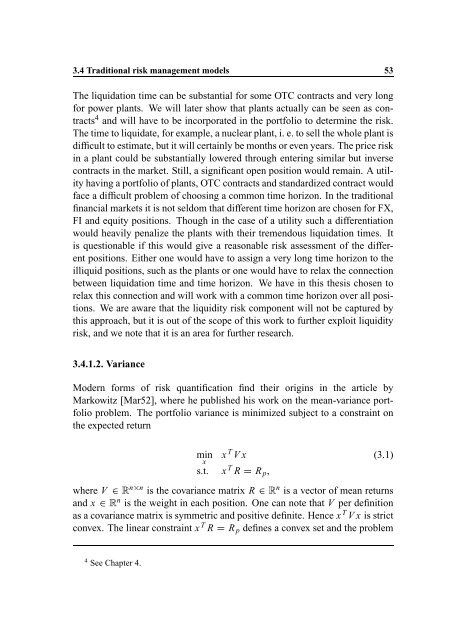Hedging Strategy and Electricity Contract Engineering - IFOR
Hedging Strategy and Electricity Contract Engineering - IFOR
Hedging Strategy and Electricity Contract Engineering - IFOR
Create successful ePaper yourself
Turn your PDF publications into a flip-book with our unique Google optimized e-Paper software.
3.4 Traditional risk management models 53<br />
The liquidation time can be substantial for some OTC contracts <strong>and</strong> very long<br />
for power plants. We will later show that plants actually can be seen as contracts<br />
4 <strong>and</strong> will have to be incorporated in the portfolio to determine the risk.<br />
The time to liquidate, for example, a nuclear plant, i. e. to sell the whole plant is<br />
difficult to estimate, but it will certainly be months or even years. The price risk<br />
in a plant could be substantially lowered through entering similar but inverse<br />
contracts in the market. Still, a significant open position would remain. A utility<br />
having a portfolio of plants, OTC contracts <strong>and</strong> st<strong>and</strong>ardized contract would<br />
face a difficult problem of choosing a common time horizon. In the traditional<br />
financial markets it is not seldom that different time horizon are chosen for FX,<br />
FI <strong>and</strong> equity positions. Though in the case of a utility such a differentiation<br />
would heavily penalize the plants with their tremendous liquidation times. It<br />
is questionable if this would give a reasonable risk assessment of the different<br />
positions. Either one would have to assign a very long time horizon to the<br />
illiquid positions, such as the plants or one would have to relax the connection<br />
between liquidation time <strong>and</strong> time horizon. We have in this thesis chosen to<br />
relax this connection <strong>and</strong> will work with a common time horizon over all positions.<br />
We are aware that the liquidity risk component will not be captured by<br />
this approach, but it is out of the scope of this work to further exploit liquidity<br />
risk, <strong>and</strong> we note that it is an area for further research.<br />
3.4.1.2. Variance<br />
Modern forms of risk quantification find their origins in the article by<br />
Markowitz [Mar52], where he published his work on the mean-variance portfolio<br />
problem. The portfolio variance is minimized subject to a constraint on<br />
the expected return<br />
min<br />
x<br />
x T V x<br />
s.t. x T R R p ,<br />
(3.1)<br />
where n` V n is the covariance matrix R n is a vector of mean returns<br />
<strong>and</strong> x<br />
n is the weight in each position. One can note that V per definition<br />
as a covariance matrix is symmetric <strong>and</strong> positive definite. Hence x T V x is strict<br />
convex. The linear constraint x T R R p defines a convex set <strong>and</strong> the problem<br />
4 See Chapter 4.
















